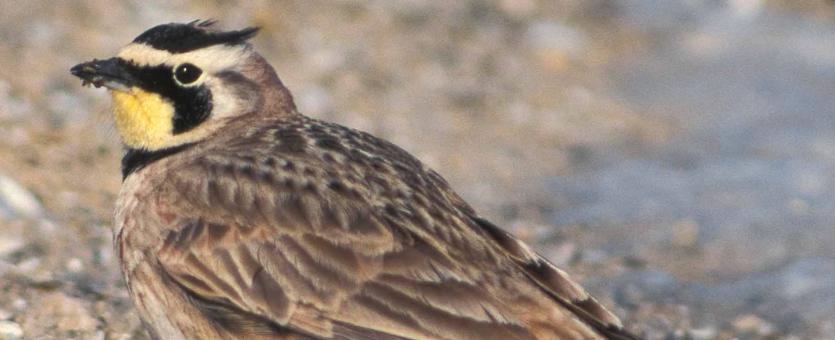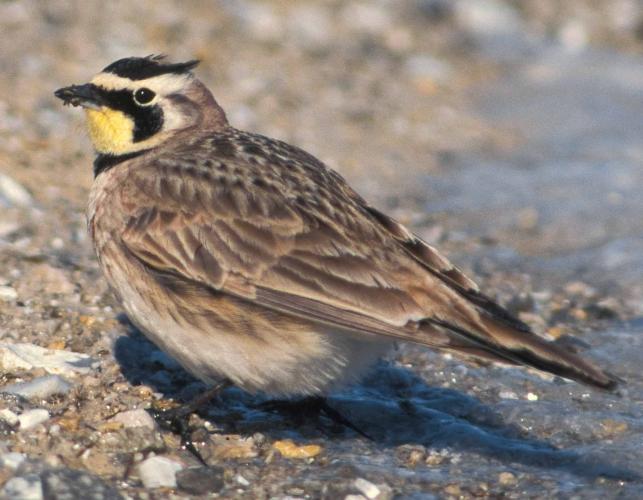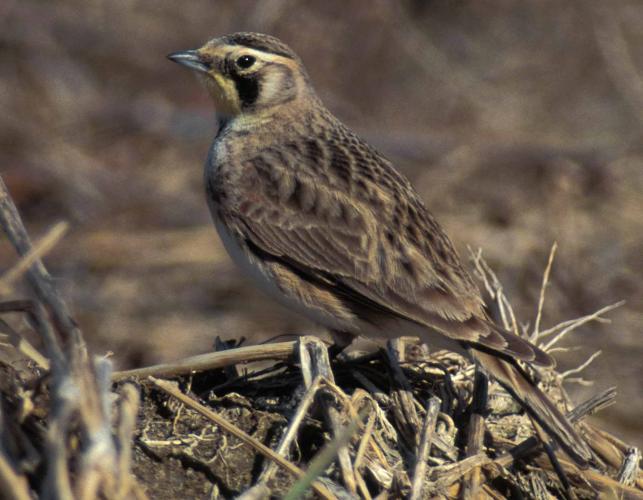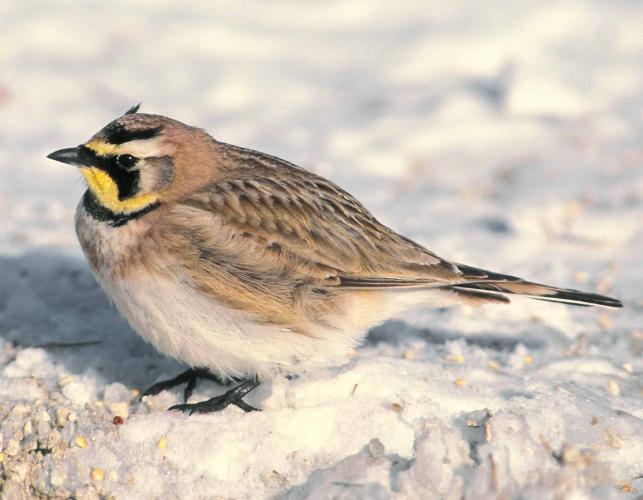
Horned lark adult upperparts are sandy brown, with a thick black eye line that continues into a streak on the cheek. The black forehead and eyebrow line extends into short “horns” on the rear crown. Underparts are white with sandy sides and flanks and a black breast band. Depending on subspecies, varying amounts of yellow are present on the eyebrow, cheek, and underparts. The wing lining, best seen in flight, is white, and the tail is black with white outer tail feathers. Young are considerably flecked with white on the upperparts. Song is a soft twittering and tinkling sound, usually delivered in flight; call is a lisping tsee or tzee-te-te. They also may sing and call from the ground.
Similar species: The black pattern on the head and breast, short “horns,” and yellow or pale throat makes this species distinctive. Also note behavioral cues: It walks rather than hops, and it prefers being on the ground rather than in trees or bushes.
Length: 7¼ inches (tip of bill to tip of tail).

Statewide.
Habitat and Conservation
Common permanent resident in large open areas with extensive bare ground. Horned larks are especially common in plowed agricultural regions, nesting early before vegetation has a chance to grow tall. If you visit open agricultural country anywhere in the state, you should find this species. Their camouflaged upperparts make them inconspicuous, but they often occur in flocks, and their movement against the ground, and their distinctively marked faces and “horns,” can help you see them.
Food
The diet includes both seeds and insects. During nesting season, insects are eaten more frequently, as the growing young require the additional protein. Ground-dwelling arthropods, such as grasshoppers, beetles, sowbugs, and caterpillars, are among the prey. Most seeds are also picked up from the ground or from low plants.
Status
As a permanent resident, common statewide, but uncommon in the Ozarks. This species also lives in Eurasia. In Europe, it is called the shore lark. This is the only true lark (in the family Alaudidae) to occur in the New World, although the sky lark, native to Eurasia, sometimes finds its way to Alaska and was introduced to Vancouver Island and persists there. British and other European literatures often mention the beautiful songs and early morning flights characteristic of larks.
Life Cycle
One of Missouri’s earliest nesting birds. Courtship songs and displays begin in January and February. The male flies up several hundred feet, giving a tinkling song at its highest ascent. Then it zooms, dartlike, to the ground, opening the wings at the last minute. Nesting can begin in February. Nests are on bare ground or in short grass, on golf courses, airports, or open agricultural fields. The young often fledge before spring plowing, but many are probably lost during field preparation.
Human Connections
Throughout Africa, Europe, and Asia, the various true members of the lark family are numerous and familiar. Early settlers in America, confronted with totally new species, often gave good-singing birds names such as “meadowlark” (which, for instance, is actually in the blackbird family).
Ecosystem Connections
Like other ground nesters, horned larks lose many young to predators such as raccoons, skunks, and weasels. Females avoid drawing attention to the nest. If a predator does draw too near, they perform a distraction display similar to the “broken-wing act” of killdeer (which are also ground nesters).


















About 350 species of birds are likely to be seen in Missouri, though nearly 400 have been recorded within our borders. Most people know a bird when they see one — it has feathers, wings, and a bill. Birds are warm-blooded, and most species can fly. Many migrate hundreds or thousands of miles. Birds lay hard-shelled eggs (often in a nest), and the parents care for the young. Many communicate with songs and calls.





















